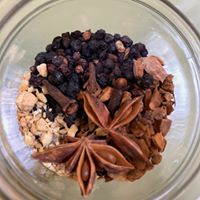INTEGRAL MEDICINE
- The Vervain Collective

- Jun 20, 2022
- 3 min read
“No matter how egregious
one's past, there is always a
spirit, a soul, an intelligence,
a consciousness, waiting to
fully live.”
–Lonny Jarrett M. Ac.
One of the most important movements of our time is Integral Medicine. Integral is defined simply as “necessary to make a whole complete.” The definition of medicine, albeit the experience may vary, is as much a political perspective as it is personal. What is more political than deciding what goes into our bodies? Integral Medicine is complementary to both the personal and political; it integrates two systems of practice for the betterment of the whole. These two systems are easily described as Western Medicine (surgeries, medications, physical diagnoses) and Eastern Medicine (meditation, qigong, acupuncture).
The book “The Web That Has No Weaver,” written by Ted Kaptchuk, describes treatments performed on set groups of patients and illustrates the results of each group. For example, a group of one hundred people was examined and diagnosed by Western Medicine Doctors. Then the same group was treated and diagnosed by Eastern Practitioners. There was a significant number of patients that had conditions identified by Eastern Practitioners that Western modalities weren’t able to register, thus potentially saving a few lives. This is due to the mechanical nature of Western Medicine; such as the idea that if it doesn’t show in a lab test, X-ray, or MRI, the condition doesn’t exist.
In Eastern Medicine, the practitioners are the mechanism of measure. Highly skilled physicians are able to determine the potential quality of life an individual has, then influence it for the betterment of the patient, and whole. Practices such as qigong, tai chi, meditation, yoga, as well as an herbal pharmacy, are some of the Eastern suggestions.
Examining the roots of both practices, Western Medicine is fairly new with the first American medical school established in 1765 at the College of Philadelphia, 257 years old to date. The requirements of receiving a doctorate then were: a male of 24 years of age (no women allowed), and to hold a bachelor’s degree granted at least three years earlier. The first mention of acupuncture is in Emperor Huangdi’s book “The Yellow Emperor’s Classic of Medicine” written in 2600 BCE, placing Eastern Medicine at an approximation of 4600 years old. This book includes knowledge regarding concepts of channels (meridians in which the Qi flows.) The accurate locations of acupuncture points however were developed later in the 15th century.
The greatest successes of medicine are to integrate the two practices. A patient (or person) should receive a Western Diagnosis, then follow with treatments in Eastern Medicine. One of my most successful teachers has thousands of clinical sessions under his belt with over 36 years of acupuncture experience. In his practice, he has shared that those with serious medical conditions that have solely pursued treatments in Western Medicine and prayer have deceased. Most of those who chose Integral Medicine are still living today.
So, make the appointment with your Western Doctor then bring the diagnosis to your Eastern Practitioner’s appointment.
It is common to ask about lineage, similar to asking where your Western Doctor graduated from, lineage determines the potential successes of Eastern treatments. In my own practice, I began by studying AMMA Therapy, a therapy based in Korean Royalty lineage brought over by Tina Sohn and Robert Sohn, predating acupuncture at over 5000 years old (before humans had needles). I also use Traditional Chinese pulse diagnosis coming from the lineage of Dr. John Shen’s work, whose teacher Ding Gan-Ren was a part of the “Menghe current,” which produced some of the most influential physicians of the 19th and 20th centuries. This helps me to determine the tendency of quality of the internal organs. Dr. John Shen paired with Dr. Leon Hammer in the U.S. to produce the “Shen-Hammer” pulse system, which I learned from Lonny Jarrett M. Ac. over the course of a two-year intensive study. For practitioners looking to engage in study with him, his courses can be found online at www.Lonny Jarrett.com for everyone else, I look forward to further discussions in the treatment room.

–Thayne Breezee AOBTA® CP






Comments